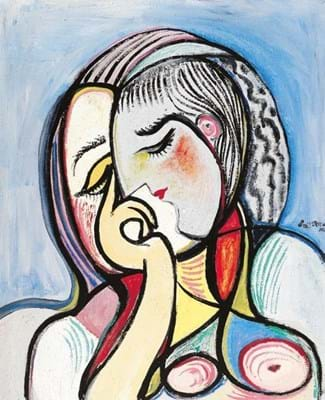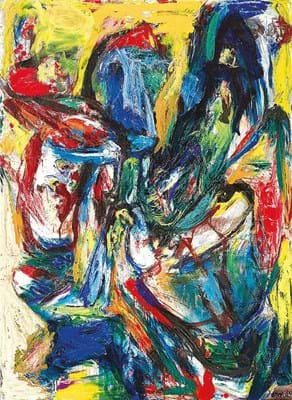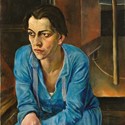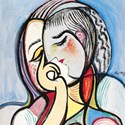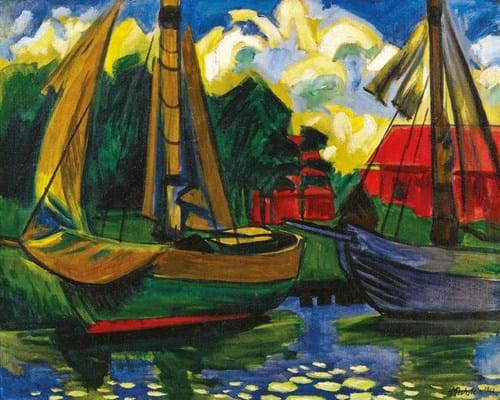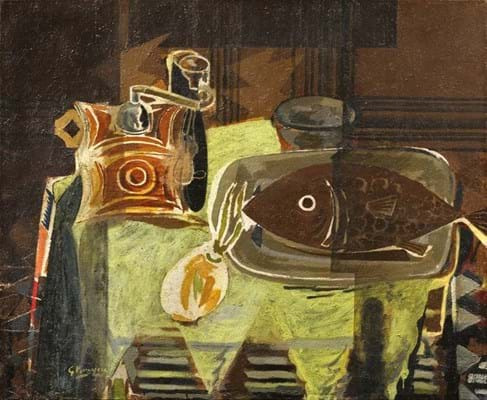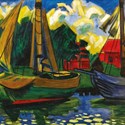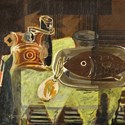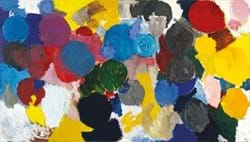It was Max Beckmann’s (1884-1950) 22in x 3ft 1in (56 x 95cm) oil painting Braunes Meer mit Möwen (Brown Sea with Seagulls), which was painted in 1941 in Amsterdam, where the artist had found a temporary refuge from the Nazis. He had hoped to emigrate to the US, but the authorities there denied him a visa until 1947.
Forced as he was to stay in Amsterdam for most of the intervening period, Beckmann nevertheless created a remarkable body of work, including the painting now on sale, which had been in a private German collection for many decades. After a short tussle it sold to an unnamed bidder for €1.2m (£1.06m), matching the lower estimate.
The next lot was of equal historical importance. The 2ft 9in x 2ft (84 x 60cm) Portrait of Helene Weigel was painted by Rudolf Schlichter (1890-1955) in 1928.
Weigel was one of the greatest German actresses of the 1920s and also the second wife of the left-wing dramatist Bertolt Brecht. In 1926 Schlichter had painted a portrait of Brecht, which is now in the collection of the Lenbachhaus in Munich.
The Weigel portrait belonged to the theatre and film actor Alexander Granach, who as a Jew and radical activist, was persecuted by the Nazis.
He was forced to flee Germany in 1933 and after living in Switzerland and Russia he eventually made it to the US, where he lived and worked (among other things he played opposite Greta Garbo in Ninotschka). He died in New York in 1945.
Before his departure from Germany he had entrusted the Weigel portrait to his then partner Lotte Lieven-Stiefel. For decades it was considered lost, but in fact it remained safely in the possession of Lieven-Stiefel’s family. The painting was now sold in agreement with the descendants of Alexander Granach.
Vigorous bidding emerged from several quarters, pushing the price up to €480,000 (£424,780), at which point a Berlin dealer sealed the deal.
Private museum
Klaus Johann Jacobs (1936-2008) was a German-Swiss industrialist who made his fortune in coffee and chocolate and invested part of it in works of art thematically connected to both.
His private museum was based in Zurich and after his death the curators decided to expand the scope of the collection and at the same time to sell several of the existing exhibits, which were consigned to Cologne auction house Lempertz (24/20% buyer’s premium).
The major attraction of the December 1 sale was George Braque’s (1882-1963) Le moulin à café, a 2ft 11in x 3ft 6in (88cm x 1.07m) composition in oil and sand from 1942. It had passed through the hands of the legendary dealer Aimé Maeght in Paris and other dealers and collectors before Jacobs bought it at Christie’s, New York, in 1996 for $580,000.
On auction day, the €400,000-600,000 estimate was soon passed and the successful bidder on the phone could only outdo his numerous competitors at €895,000 (£792,040).
Over the years there has been consistent interest in works by the German Expressionist Hermann Max Pechstein (1881-1955).
His 2ft 8in x 3ft 3in (81cm x 1m) painting Zwei Kutter im Hafen von Leba (Two Fishing Boats in the Harbour at Leba) was dated 1922.
The artist was fascinated by the calm atmosphere of the country near the port on the Baltic coast, having left the hustle, bustle and poverty of Berlin soon after the end of the First World War.
He executed numerous sketches and paintings of the area. This one was fresh to the market, having been owned exclusively by collectors since the 1950s. Another phone bidder secured his prize for €410,000 (£362,830), just above the lower estimate.
Filla up
The record-breaking result of €2m (£1.76m) for a gouache and black crayon drawing Reclining Woman by Egon Schiele (see ATG’s online story) dominated the sales of modern and contemporary art at Dorotheum (25/22/15% buyer’s premium) on November 21-22.
There were, however, several other noteworthy results. Among them was the price for Jeune fille pensive, a 3ft 3in x 2ft 6in (1m x 81cm) canvas by Emil Filla (1882-1953), a leading exponent of the Czechoslovakian avant-garde.
Before the outbreak of the First World War he often visited Paris, meeting Chagall, Braque and Picasso.
The long-lasting influence of the latter can clearly be seen in the painting on offer, from 1933.
Six years later Filla was arrested by the German authorities and spent the whole of the war in concentration camps, managing however to survive. Soon after his release a first exhibition of his works was held in Prague, indicative of his standing.
Today’s collectors also appreciate his art, as can be seen by the fact that his Pensive Girl trebled the estimate to sell for €360,000 (£318,585).
In the Contemporary sale on the following day substantial interest appeared for Brokigt brak-Patchy quarrel, a 4ft 7in x 3ft 5in (1.4 x 1.04m) oil painting by Asger Jorn (1914-1973), executed in 1964.
It was last offered at auction at Christie’s in Amsterdam in 2008, when it was knocked down for €170,000 to a collector, who later passed it on to another European collector who in turn consigned to Dorotheum. It was now in the catalogue with an estimate of €150,000-200,000, but changed hands for €360,000 (£318,585).




